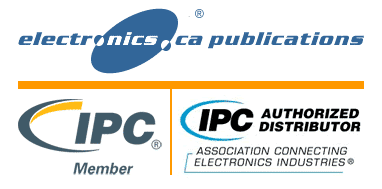It takes a lot to be successful in electronics assembly. Get the reference documents you need on all aspects of the job from solder materials, component characteristics, manufacturing and quality requirements, and acceptability of the final assembly. Includes 41 key documents for SMT and through-hole assembly, including the widely used IPC-A-610, J-STD-001 and IPC-A-620. Get the complete IPC standards collection and save 55% on individual document prices. Users can also purchase and download IPC standards from Electronics.ca Publications by following IPC specs below.
Electronics Assembly IPC Standards Collection Includes
IPC 2611 Generic Requirements for Electronic Product Documentation
IPC 2612-2 Sectional Requirements for Electronic Diagramming Documentation (Schematic and Logic Descript
IPC 2612-1 Sectional Requirements for Electronic Diagramming Symbol Generation Methodology
IPC 3406 Guidelines for Electrically Conductive Surface Mount Adhesives
IPC 3408 General Requirements for Anisotropically Conductive Adhesives Films
IPC 7095C Design and Assembly Process Implementation for BGAs
IPC 7351B Generic Requirements for Surface Mount Design and Land Pattern Standard
IPC 9202 Material and Process Characterization/Qualification Test Protocol for Assessing Electrochemic
IPC 9203 Users Guide to IPC-9202 and the IPC-B-52 Standard Test Vehicle
IPC 9701A Performance Test Methods and Qualification Requirements for Surface Mount Solder Attachments
IPC 9702 IPC/JEDEC Monotonic Bend Characterization of Board-Level Interconnects
IPC 9703 IPC/JEDEC Mechanical Shock Test Guidelines for Solder Joint Reliability
IPC 9704A Printed Circuit Assembly Strain Gage Test Guideline
IPC 9706 Mechanical Shock In-situ Electrical Metrology Test Guidelines for FCBGA SMT Component Solder
IPC 9707 Spherical Bend Test Method for Characterization of Board Level Interconnects
IPC 9708 Test Methods for Characterization of Printed Board Assembly Pad Cratering
IPC 9709 Test Guidelines for Acoustic Emission Measurement during Mechanical Testing
IPC A-610F Acceptability of Electronics Assembly
IPC A-620B IPC/WHMA-A-620B Requirements and Acceptance for Cable and Wire Harness Assemblies
IPC C-406 Design & Application Guidelines for Surface Mount Connectors
IPC CA-821 General Requirements for Thermally Conductive Adhesives
IPC CC-830B Qualification and Performance of Electrical Insulating Compound for Printed Wiring Assemblies
IPC CM-770E Component Mounting Guidelines for Printed Boards
IPC D-326A Information Requirements for Manufacturing Printed Circuit Boards and Other Electronic Assemblies
IPC FC-234A Pressure Sensitive Adhesive (PSA) Assembly Guidelines for Flexible, Rigid or Rigid-Flex Printed Boards
IPC HDBK-001E Handbook and Guide to Supplement J-STD-001
IPC HDBK-005 Guide to Solder Paste Assessment
IPC JP002 JEDEC/IPC Current Tin Whiskers Theory and Mitigation Practices Guideline
IPC J-STD-001F Requirements for Soldered Electrical and Electronic Assemblies
IPC J-STD-002D EIA/IPC/JEDEC J-STD-002D Solderability Tests for Component Leads, Terminations, Lugs, Terminals and Wires
IPC J-STD-003C-WAM1 Solderability Tests for Printed Boards
IPC J-STD-004B Requirements for Soldering Fluxes
IPC J-STD-005A Requirements for Soldering Pastes
IPC J-STD-006C Requirements for Electronic Grade Solder Alloys and Fluxed and Non-Fluxed Solid Solders
IPC J-STD-020D-1 IPC/JEDEC Moisture/Reflow Sensitivity Classification for Nonhermetic Solid State Surf
IPC J-STD-027 Mechanical Outline Standard for Flip Chip and Chip Size Configurations
IPC J-STD-028 Performance Standard for Construction of Flip Chip and Chip Scale Bumps
IPC J-STD-030A Selection and Application of Board Level Underfill Materials
IPC J-STD-033C-1 Handling, Packing, Shipping and Use of Moisture/Reflow Sensitive Surface Mount Device
IPC J-STD-075 Classification of Non-IC Electronic Components for Assembly Processes
IPC MC-790 Guidelines for Multichip Module Technology Utilization
IPC S-816 SMT Process Guideline & Checklist
IPC SM-780 Component Packaging & Interconnecting with Emphasis on Surface Mounting
IPC SM-784 Guidelines for Chip-on-Board Technology Implementation
IPC SM-785 Guidelines for Accelerated Reliability Testing of Surface Mount Attachments
IPC SM-817 General Requirements for Dielectric Surface Mounting Adhesives
IPC SM-817A General Requirements for Dielectric Surface Mount Adhesives
IPC T-50K Terms and Definitions for Interconnecting and Packaging Electronic Circuits
IPC TR-001 An Introduction to Tape Automated Bonding Fine Pitch Technology
Electronics Assembly IPC Standards Collection










